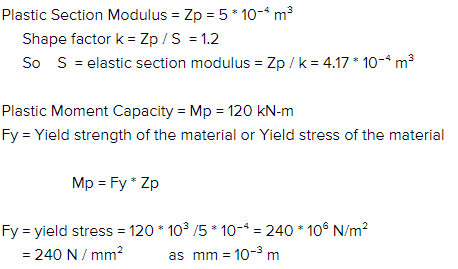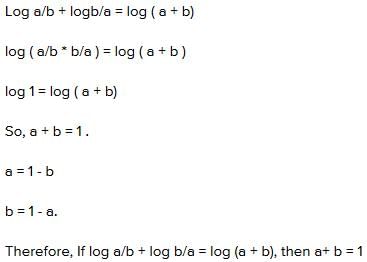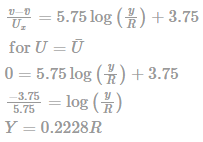All Exams >
Civil Engineering (CE) >
6 Months Preparation for GATE Civil Engg >
All Questions
All questions of Practice Test: Full Length for Civil Engineering (CE) Exam
In an exam, the average was found to be 50 marks. After deducting computational errors the marks of the 100 candidates had to be changed from 90 to 60 each and average came down to 45 marks. Total number of candidates who took the exam was:- a)150
- b)200
- c)300
- d)600
Correct answer is option 'D'. Can you explain this answer?
a)
150
b)
200
c)
300
d)
600
|
|
Dipika Ahuja answered |
Let number of candidates be n
50 × n – 100 × 30 = 45 × n
n = 600
50 × n – 100 × 30 = 45 × n
n = 600
6 boys and 6 girls sit in a row at random. Find the probability that 1) The six girls sit together 2) The boys and girls sit alternately.- a)1/462
- b)

- c)

- d)

Correct answer is option 'A'. Can you explain this answer?
6 boys and 6 girls sit in a row at random. Find the probability that 1) The six girls sit together 2) The boys and girls sit alternately.
a)
1/462
b)
c)
d)

|
Vertex Academy answered |
\Total ways of making sit 12 persons 12!
Considering set of 6 girls as a single group. Within the group girls can be arranged in 6! Ways. Now only among 7 persons—> 6 boys + 1 girl group arrangement needs to be done. Thus, number of ways for the same = 7!.
Therefore, probability = Favourable outcomes/ total number of outcomes = (7!) (6!) / (12!) = 1/1322
We can only make sit boys and girls in alternate manner in two possible ways, boys at even and girls at even. But, among boys group and girls group itself, rearrangement can be done in 6! Ways each.
Therefore, probability =(2)(6!)(6!)/ 12! = 1/462
Considering set of 6 girls as a single group. Within the group girls can be arranged in 6! Ways. Now only among 7 persons—> 6 boys + 1 girl group arrangement needs to be done. Thus, number of ways for the same = 7!.
Therefore, probability = Favourable outcomes/ total number of outcomes = (7!) (6!) / (12!) = 1/1322
We can only make sit boys and girls in alternate manner in two possible ways, boys at even and girls at even. But, among boys group and girls group itself, rearrangement can be done in 6! Ways each.
Therefore, probability =(2)(6!)(6!)/ 12! = 1/462
The value of bearing capacity factor for cohesion, Nc, for piles as per Meyerhof, is taken as :- a) 6.2
- b)12.0
- c) 9.0
- d)5.14
Correct answer is option 'D'. Can you explain this answer?
The value of bearing capacity factor for cohesion, Nc, for piles as per Meyerhof, is taken as :
a)
6.2
b)
12.0
c)
9.0
d)
5.14
|
|
Sanya Agarwal answered |
Meyehoff bearing capacity factors for cohesive clays (phi=0) are
Nc = 5.14; Nq = 1; Ny = 0
Nc = 5.14; Nq = 1; Ny = 0
A clayey soil sample in a consolidometer test showed decrease in void ratio from 1.15 to 1.05 when the pressure was increased from 0.30 kgf/cm2 to 0.60 kgf/cm2. If the same soil shows 10% more decrease in void ratio when the pressure was increased from 0.30 kgf/cm2 to 0.80 kgf/cm2, then change in coefficient of consolidation observed during the test will be?Take initial coefficient of consolidation observed from test when the pressure was increased from 0.30 kgf/cm2 to 0.60 kgf/cm2 to be 12 m2/year.- a)4.5 m2/year (decrease)
- b)3.22 m2/year (increase)
- c)12 m2/year (increase)
- d)3.22 m2/year (decrease)
Correct answer is option 'B'. Can you explain this answer?
A clayey soil sample in a consolidometer test showed decrease in void ratio from 1.15 to 1.05 when the pressure was increased from 0.30 kgf/cm2 to 0.60 kgf/cm2. If the same soil shows 10% more decrease in void ratio when the pressure was increased from 0.30 kgf/cm2 to 0.80 kgf/cm2, then change in coefficient of consolidation observed during the test will be?
Take initial coefficient of consolidation observed from test when the pressure was increased from 0.30 kgf/cm2 to 0.60 kgf/cm2 to be 12 m2/year.
a)
4.5 m2/year (decrease)
b)
3.22 m2/year (increase)
c)
12 m2/year (increase)
d)
3.22 m2/year (decrease)
|
|
Sanvi Kapoor answered |
Coefficient of compressibility (av)=

Δe = change in void ratio
 increase in effective stress
increase in effective stressCoefficient of volume compressibity

e0 = initial void ratio
Also,
k = cvmvγw
k = permeability of soil Sample
cv = coefficient of consolidation
mv = coefficient of volume compressibility
Calculation:
Δe1 = 1.15 – 1.05
Δe1 = 0.10
Δσ1 = 0.60 – 0.30
Δσ1 = 0.30 kgf/cm2



 = 3.80×10−3cm2/sec
= 3.80×10−3cm2/sec k = 3.80 × 10–3 × 0.155 × γw
Now,
Δe2 = 1.10 × 0.10 = 0.11
Δσ2 = 0.80 – 0.30
Δσ2 = 0.50


As permeability of both the sample is Sames,
So,

3.80×10−3×0.155=cv2×0.122
cv2=4.83×10−3cm2/sec
cv2=15.22m2/ year
Change in coefficient of consolidation:
Δcv=cv2−cv1
Δcv = 15.22 – 12
Δcv = 3.22 m2/year
Following data refers to the activities of a project, where, node 1 refers to the start and node 5 refers to the end of the project.
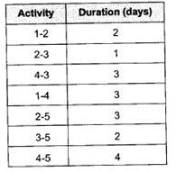 The critical path (CP) in the network is
The critical path (CP) in the network is- a)1-2-3-5
- b)1-4-3-5
- c)1-2-3-4-5
- d)1-4-5
Correct answer is option 'B'. Can you explain this answer?
Following data refers to the activities of a project, where, node 1 refers to the start and node 5 refers to the end of the project.


The critical path (CP) in the network is
a)
1-2-3-5
b)
1-4-3-5
c)
1-2-3-4-5
d)
1-4-5
|
|
Ravi Singh answered |
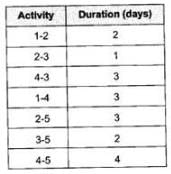
The critical path is the sequence of activities with the longest duration. A delay in any of these activities will result in a delay for the whole project.
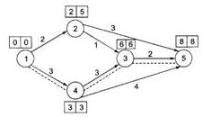
Critical path = 1‒4‒3‒5 = 3+3+2 = 8
Note: Critical path is the longest path through a network of activities, which in-turn, determines the shortest time possible to complete all tasks in the network (i.e. the shortest time to complete the project).
The length of a new runway to be constructed under the standard condition is 1710 m. The elevation of airport site is 750 m above the mean sea level. The airport reference temperature and the effective gradient of the runway are 25.7oC and 1.6% respectively. If the runway is to be constructed as per the International Civil Aviation Organization (ICAO) recommendations, then the corrected length of the runway after elevation and temperature correction (in km, up to two correct decimal place) will be ______.
Correct answer is '2307-2310'. Can you explain this answer?
The length of a new runway to be constructed under the standard condition is 1710 m. The elevation of airport site is 750 m above the mean sea level. The airport reference temperature and the effective gradient of the runway are 25.7oC and 1.6% respectively. If the runway is to be constructed as per the International Civil Aviation Organization (ICAO) recommendations, then the corrected length of the runway after elevation and temperature correction (in km, up to two correct decimal place) will be ______.
|
|
Tanvi Shah answered |
Correction for elevation: 7% increase per 300 m
So, correction = 

= 299.25 m
Corrected length = 1710 + 299.25 = 2009.25 m
Correction for temperature: 1% increase per degree rise in temperature
Standard atmospheric temperature = 15 – 0.0065 × 750 = 10.125°C
Rise of temp = 25.7°C – 10.125°C = 15.575°C
 15.575 = 311.43375m
15.575 = 311.43375mCorrect length = 2009.25 + 311.43375 = 2320.684 m
Check for total correction for elevation plus temperature


According to ICAO, the total correction for elevation plus temperature should not exceed by 35%.
Hence, the total correction for elevation plus temperature correction =  1710 = 598.5m
1710 = 598.5m
 1710 = 598.5m
1710 = 598.5mTherefore, the corrected length of the runway = 1710 + 598.5 = 2308.5 m
Two points are chosen randomly on a line 9 cm long. Determine the probability that the distance between them is less than 3 cm
Correct answer is '0.5-0.6'. Can you explain this answer?
Two points are chosen randomly on a line 9 cm long. Determine the probability that the distance between them is less than 3 cm
|
|
Lavanya Menon answered |
x: The distance of first point from the start of the line
y: distance of second point from the start of the line segment
x,y ϵ[0,9]
So sample space is Area of region bounded by
x ≥ 0, y ≥ 0, x ≤ 9, y ≤ 9
This is square of side 9
Area = 81 cm2
The region of our interest is
|x-y| < 3
0 ≤ x ≤ 9
0 ≤ y ≤ 9
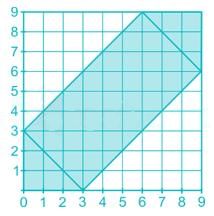
Area of shaded region = 2 (area of triangle) + area of rectangle

= 45
Probability = 45/81 =0.55
Consider the following statements
1) Cambium layer is between sapwood and heartwood
2) Heartwood is otherwise termed as deadwood
3) Timber used for construction is obtained from heartwood
Which of the following is/are correct statements?- a)1, 2 and 3
- b)2 and 3 only
- c) 1 and 3 only
- d) 2 only
Correct answer is option 'B'. Can you explain this answer?
1) Cambium layer is between sapwood and heartwood
2) Heartwood is otherwise termed as deadwood
3) Timber used for construction is obtained from heartwood
Which of the following is/are correct statements?
a)
1, 2 and 3
b)
2 and 3 only
c)
1 and 3 only
d)
2 only
|
|
Yash Patel answered |
Cambium layer is between inner bark and sapwood. Heartwood is dead wood which does not take part in the growth of tree and is used for construction.
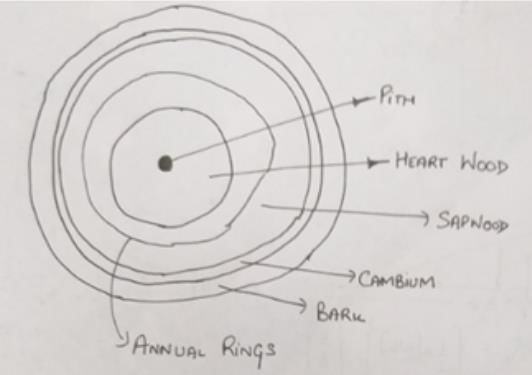

Standard 5-day BOD of a waste water sample is nearly x% of the ultimate BOD, where x is- a)48
- b) 58
- c)68
- d)78
Correct answer is option 'C'. Can you explain this answer?
Standard 5-day BOD of a waste water sample is nearly x% of the ultimate BOD, where x is
a)
48
b)
58
c)
68
d)
78
|
|
Ravi Singh answered |
BOD5 = BODu [ 1-10-k x 5] and the usual value of deoxygenation constant is 0.1
Substituting, the value of k BOD5 = BODu [0.6837]
Therefore, value of x will be 68.37%
Substituting, the value of k BOD5 = BODu [0.6837]
Therefore, value of x will be 68.37%
A transmission tower carries a vertical load of 10000 kg, the vertical stress increment at a depth 6 m directly below the tower as per Boussinesq’s theory is____Pa.
Correct answer is between '1300,1350'. Can you explain this answer?
A transmission tower carries a vertical load of 10000 kg, the vertical stress increment at a depth 6 m directly below the tower as per Boussinesq’s theory is____Pa.
|
|
Tanvi Shah answered |
Concept:
Vertical stress increment at a any depth (z) at a radial distance (r) as per Boussines’q theory is:

Where,
KB = Boussinesq’s influence factor

Calculation:
At r = 0 m,

Q = 10000 × 9.81 = 98100 N
z = 6 m

A river 5 m deep consists of a sand bed with saturated unit weight of 20 kN/m3 . vw = 9.81 kN/m3. The effective vertical stress at 5 m from the top of sand bed is- a)41 kN/m2
- b)51 kN/m2
- c)55 kN/m2
- d)53 kN/m2
Correct answer is option 'B'. Can you explain this answer?
A river 5 m deep consists of a sand bed with saturated unit weight of 20 kN/m3 . vw = 9.81 kN/m3. The effective vertical stress at 5 m from the top of sand bed is
a)
41 kN/m2
b)
51 kN/m2
c)
55 kN/m2
d)
53 kN/m2

|
Bijoy Kapoor answered |
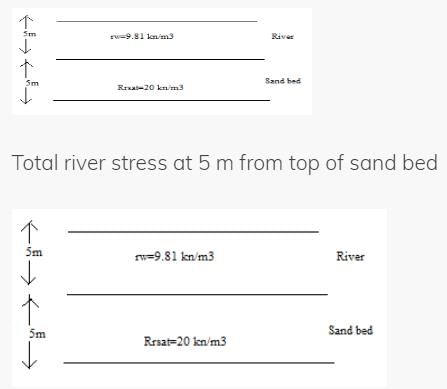
= 5x9.81+5x20=149.05 kn/m3
pore water pressure at 10mm
=9.81x10=98.1 kn/m3
∴ effective verticle stress = 50.95 kn/m3
In a particular bank 60% of the customers applied for a loan are rejected. If 4 new loan applications are received, find the probability that exactly 3 of them are accepted.- a)0.1536
- b)0.3456
- c)0.45
- d)0.75
Correct answer is option 'A'. Can you explain this answer?
In a particular bank 60% of the customers applied for a loan are rejected. If 4 new loan applications are received, find the probability that exactly 3 of them are accepted.
a)
0.1536
b)
0.3456
c)
0.45
d)
0.75
|
|
Lavanya Menon answered |
n = 4, p = 0.4, q = 0.6
Applying Binomial theorem:
Applying Binomial theorem:
p(X = 3) = 
p(X = 3) = 
= 0.1536
The maximum permissible deflection for a gantry girder, spanning over 6 m, on which an EOT (electric overhead travelling) crane of capacity 200 kN is operating, is- a)8 mm
- b)10 mm
- c)12 mm
- d)18 mm
Correct answer is option 'A'. Can you explain this answer?
The maximum permissible deflection for a gantry girder, spanning over 6 m, on which an EOT (electric overhead travelling) crane of capacity 200 kN is operating, is
a)
8 mm
b)
10 mm
c)
12 mm
d)
18 mm
|
|
Rishabh Choudhury answered |
Maximum vertical deflection of Gantry girder for EOT of capacity less than 500KN is ( L/750), where L in mm
For EOT having capacity more then 500KN deflection is (L/1000) and for manually operated crane Deflection is (L/500)
For EOT having capacity more then 500KN deflection is (L/1000) and for manually operated crane Deflection is (L/500)
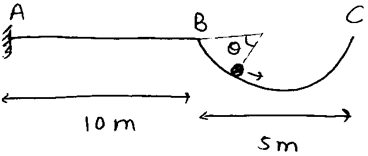 Portion BC is semi-circulate. If after several oscillation ball of mass 10 Kg comes to rest. The bending moment at A when ball is at rest will be ? Take g = 9.81 m/s2.
Portion BC is semi-circulate. If after several oscillation ball of mass 10 Kg comes to rest. The bending moment at A when ball is at rest will be ? Take g = 9.81 m/s2.- a)1226 N-m
- b)1345 N-m
- c)1468 N-m
- d)1534 N-m
Correct answer is option 'A'. Can you explain this answer?
Portion BC is semi-circulate. If after several oscillation ball of mass 10 Kg comes to rest. The bending moment at A when ball is at rest will be ? Take g = 9.81 m/s2.
a)
1226 N-m
b)
1345 N-m
c)
1468 N-m
d)
1534 N-m
|
|
Lavanya Menon answered |
At rest, ball is at lower most potion of semi-circle.
BM at A = 10g ´ (10 2.5)
= 10 ´ 9.81 ´ 12.5
= 1226.25 N - m
An I-section bean is fabricated with plates having an elastic section modulus of 200 × 10-5m3. If the laterally unsupported steel beam is classified as a semi-compact section, then the design plastic moment capacity of the beam considering Fe 410 grade of steel and the partial safety factor of material as 1.1 will be ____ kNm. (Use Bending stress reduction factor (XLT= 1.0) - a)453-456
Correct answer is '453-456'. Can you explain this answer?
An I-section bean is fabricated with plates having an elastic section modulus of 200 × 10-5m3. If the laterally unsupported steel beam is classified as a semi-compact section, then the design plastic moment capacity of the beam considering Fe 410 grade of steel and the partial safety factor of material as 1.1 will be ____ kNm. (Use Bending stress reduction factor (XLT= 1.0)
a)
453-456
|
|
Tanvi Shah answered |
Concept:
The bending strength or the plastic moment capacity of a laterally unsupported beam is given by:
Md = βb Zp fbd
Where
βb = 1 → for plastic and concept section
 for semi - compact section.
for semi - compact section. Ze = Elastic section modulus
Zp = Plastic section modulus
fbd = design bending compressive strength

ymo = Partial safety factor for material = 1.1
XLT = bending stress reduction factor to account for lateral torsional buckling
XLT ≤ 1.0
Calculation:
For a semi-compact section of a laterally unsupported steel bean plastic moment capacity

XLT = 1.0
γmo = 1.1
fy = 250 Mpa for grade fe 410

Md = 200 = 454.54 kNm
= 454.54 kNm
 = 454.54 kNm
= 454.54 kNmPlate bearing test with 20 cm diameter plate on soil subgrade yielded a pressure of 1.25 x 105 N/m2 at 0.5 cm deflection. What is the elastic modulus of subgrade ?- a)56.18 x 105 N/m2
- b)22.10 x 105 N/m2
- c)44.25 x 105 N/m2
- d)None.
Correct answer is option 'D'. Can you explain this answer?
Plate bearing test with 20 cm diameter plate on soil subgrade yielded a pressure of 1.25 x 105 N/m2 at 0.5 cm deflection. What is the elastic modulus of subgrade ?
a)
56.18 x 105 N/m2
b)
22.10 x 105 N/m2
c)
44.25 x 105 N/m2
d)
None.

|
Rahul Chatterjee answered |
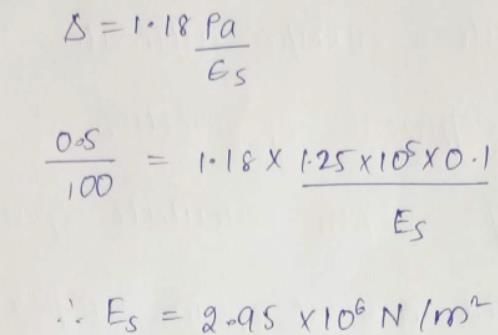
When a four digit number is divided by 65, it leaves a remainder of 29. If the same number is divided by 13, the remainder would be______
Correct answer is '3'. Can you explain this answer?
When a four digit number is divided by 65, it leaves a remainder of 29. If the same number is divided by 13, the remainder would be______

|
Simran Dasgupta answered |
Let number is N
N = 65 k +29
Now 



∴ Remainder = 3
As per IS 10500: 2012, the permissible limits in absence of alternate source of water for calcium and magnesium in the drinking water respectively will be (in ppm)- a)75 and 30
- b)45 and 30
- c)200 and 100
- d)250 and 125
Correct answer is option 'C'. Can you explain this answer?
As per IS 10500: 2012, the permissible limits in absence of alternate source of water for calcium and magnesium in the drinking water respectively will be (in ppm)
a)
75 and 30
b)
45 and 30
c)
200 and 100
d)
250 and 125

|
Shail Rane answered |
As per IS 10500: 2012,
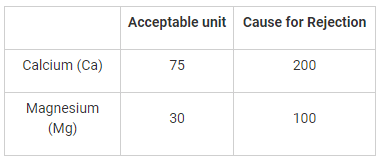
As per IS 1055: 2012, the permissible limits in absence of alternate source of water for calcium and magnesium in the drinking water respectively will be 200 ppm and 100 ppm.
A square plate 5m × 5m hangs in water from one of its corners and its centroid lies at 8m from the free water surface. Find the total pressure force on the top half of the plate. 
- a)2000 kN
- b)1000 kN
- c) 850 kN
- d) None of these
Correct answer is option 'C'. Can you explain this answer?
a)
2000 kN
b)
1000 kN
c)
850 kN
d)
None of these

|
Rounak Choudhary answered |
Pressure force = Pressure at CG × Area of plate
h is the height of CG from top of water surface.
A trapezoidal section of an open channel has side slope 2H : 1V. If bottom width is 'b’ and depth d’, the relation between b & d for most economical trapezoidal section of the channel is:- a)b = 0.47 d
- b)b/d = 0.5
- c)b = 2d
- d)d2 b = 2
Correct answer is option 'A'. Can you explain this answer?
A trapezoidal section of an open channel has side slope 2H : 1V. If bottom width is 'b’ and depth d’, the relation between b & d for most economical trapezoidal section of the channel is:
a)
b = 0.47 d
b)
b/d = 0.5
c)
b = 2d
d)
d2 b = 2
|
|
Tanishq Yadav answered |
For most of the economical open channel Trapezoidal section,
Half of top width should be equal to length of the side slope (n:1=H:V)
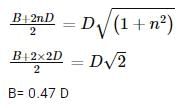
The dimensions for the flexural rigidity of a beam element in mass (M), length (L) and time (T) is given by:- a)MT-2
- b)M-1T2
- c)ML-1T-2
- d)ML3T-2
Correct answer is option 'D'. Can you explain this answer?
The dimensions for the flexural rigidity of a beam element in mass (M), length (L) and time (T) is given by:
a)
MT-2
b)
M-1T2
c)
ML-1T-2
d)
ML3T-2
|
|
Sanvi Kapoor answered |
In a beam, the flexural rigidity (EI) varies along the length as a function of x as shown in equation:

Where E is the young's modulus (in Pasual, Pa), I is the second moment of area (in m4). Y is the traverse displacement of the beam x and M(x) is the bending moment at x. The SI unit of flexural rigidity is thus Pa. m4 or Nm4
∴ Dimension is ML3T–2

Where E is the young's modulus (in Pasual, Pa), I is the second moment of area (in m4). Y is the traverse displacement of the beam x and M(x) is the bending moment at x. The SI unit of flexural rigidity is thus Pa. m4 or Nm4
∴ Dimension is ML3T–2
The speed and the theoretical maximum capacity of a single lane highway are 5m/s and 900 vehicle per hour respectively. The space headway and time headway respectively are:- a)5.55 m and 4 sec
- b)15 m and 3 sec
- c)10 m and 2 sec
- d)20 m and 4 sec
Correct answer is option 'D'. Can you explain this answer?
The speed and the theoretical maximum capacity of a single lane highway are 5m/s and 900 vehicle per hour respectively. The space headway and time headway respectively are:
a)
5.55 m and 4 sec
b)
15 m and 3 sec
c)
10 m and 2 sec
d)
20 m and 4 sec
|
|
Lavanya Menon answered |
Theoretical maximum capacity of single lane can be expressed as

where, S = Capacity of single lane in vehicle per hour.
V = Speed in kmph
S = Space headway
Theoretical capacity can also be written as

Where, Ht = time headway
Calculation:
Space Headway (S) =


Time Headway (Ht) = 3600/900 sec
= 4 sec
Extreme focus on syllabus and studying for tests has become such a dominant concern of Indian students that they close their minds to anything ___________ to the requirements of the exam.- a)Related
- b)Extraneous
- c)Outside
- d)Useful
Correct answer is option 'B'. Can you explain this answer?
a)
Related
b)
Extraneous
c)
Outside
d)
Useful
|
|
Ashutosh Kulkarni answered |
Extraneous – irrelevant or unrelated to the subject being dealt with
MPN index is a measure of one of the following :- a)Coliform bacteria
- b)BOD5
- c)Dissolved Oxygen Content
- d)Hardness
Correct answer is option 'A'. Can you explain this answer?
MPN index is a measure of one of the following :
a)
Coliform bacteria
b)
BOD5
c)
Dissolved Oxygen Content
d)
Hardness
|
|
Ravi Singh answered |
MPN- Most Probable Number used to measure Coliform Bacterial
Wrinkler’s Method is used to measure dissolved oxygen and further, which is used to determine BOD5
Hardness is measured in mg/L as CaCO3 via various methods like lime treatment, boiling.
Wrinkler’s Method is used to measure dissolved oxygen and further, which is used to determine BOD5
Hardness is measured in mg/L as CaCO3 via various methods like lime treatment, boiling.
Consider the following statements P and Q:(P):If M =  then M is singular.(Q): Let S be a diagonalizable matrix. If T is a matrix such that S + 5 T = I, then T is diagonalizable.Which of the above statements hold TRUE?
then M is singular.(Q): Let S be a diagonalizable matrix. If T is a matrix such that S + 5 T = I, then T is diagonalizable.Which of the above statements hold TRUE?- a)Both P and Q
- b)Only P
- c)Only Q
- d)Neither P nor Q
Correct answer is option 'C'. Can you explain this answer?
Consider the following statements P and Q:
(P):If M =  then M is singular.
then M is singular.
 then M is singular.
then M is singular.(Q): Let S be a diagonalizable matrix. If T is a matrix such that S + 5 T = I, then T is diagonalizable.
Which of the above statements hold TRUE?
a)
Both P and Q
b)
Only P
c)
Only Q
d)
Neither P nor Q

|
Gate Gurus answered |

A matrix is said to be singular, if determinant of that matrix is zero.

= 1 (18 – 12) - 1 (9 – 4) + 1 (3 – 2)
= 6 – 5 + 1 = 2 ≠ 0
M is non singular
(Q) A matrix can be diagonalizable when it has distinct eigen values
S is a diagonalizable matrix. Hence, has distinct eigen values.
Let S be a 3 × 3 matrix and the eigen values of s are λ1, λ2, λ3
Given that, S + 5T = I

From the properties of Eigen values,
(a) If λ1 is an eigen value of matrix A, then -λ1 will be on eigen value of matrix -A.
(b) If λ1 is an eigen value of matrix A, then (λ1 + 1) will be an eigen value of matrix (A + I)
(c) If λ1 is an eigen value of matrix A, then  will be an eigen value of matrix
will be an eigen value of matrix  where K is a scalar.
where K is a scalar.
 will be an eigen value of matrix
will be an eigen value of matrix  where K is a scalar.
where K is a scalar.From the above properties, eigen values of T are,
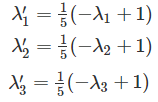
As λ1, λ2, λ3 are distinct values, λ′1,λ′2,λ′3 will be distinct.
Hence, matrix T is diagonalizable
So, only Q is true.
The nominal bearing strength of the bolt is given by 2.5 Kb dt fu, where Kb depends upon:
1) Edge distance
2) Bolt diameter
3) Diameter of bolt hole
4) Ultimate tensile stress of bolt
5) Ultimate tensile stress of plate Of the above- a)1, 3, 4 and 5 are correct
- b)1, 2 and 4 are correct
- c)3, 4 and 5 are correct
- d)2, 3, 4 and 5 are correct
Correct answer is option 'A'. Can you explain this answer?
The nominal bearing strength of the bolt is given by 2.5 Kb dt fu, where Kb depends upon:
1) Edge distance
2) Bolt diameter
3) Diameter of bolt hole
4) Ultimate tensile stress of bolt
5) Ultimate tensile stress of plate Of the above
1) Edge distance
2) Bolt diameter
3) Diameter of bolt hole
4) Ultimate tensile stress of bolt
5) Ultimate tensile stress of plate Of the above
a)
1, 3, 4 and 5 are correct
b)
1, 2 and 4 are correct
c)
3, 4 and 5 are correct
d)
2, 3, 4 and 5 are correct

|
Simran Saha answered |
Kb does not depend on bolt diameter.
In an irrigation project, in a certain year, 70% and 46% of the culturable command area in Kharif and Rabi, respectively, remained without water and the rest of the area got irrigation water. The intensity of irrigation in that year for the project was- a)116%
- b)84%
- c)42%
- d)58%
Correct answer is option 'B'. Can you explain this answer?
In an irrigation project, in a certain year, 70% and 46% of the culturable command area in Kharif and Rabi, respectively, remained without water and the rest of the area got irrigation water. The intensity of irrigation in that year for the project was
a)
116%
b)
84%
c)
42%
d)
58%
|
|
Kabir Verma answered |
The annual intensity of irrigation is the sum of total intensities of irrigation of all the seasons of the year
= Intensity in Rabi + Intensity in Kharif
= (100-46) + (100-70)
= 84%
A car starts from rest and accelerates at a speed of 35 m/s in time 18 seconds. Find the average acceleration of the car?- a) 2.9 m/s2
- b)3.75 m/s2
- c)7.25 m/s2
- d)1.94 m/s2
Correct answer is option 'D'. Can you explain this answer?
A car starts from rest and accelerates at a speed of 35 m/s in time 18 seconds. Find the average acceleration of the car?
a)
2.9 m/s2
b)
3.75 m/s2
c)
7.25 m/s2
d)
1.94 m/s2

|
Sanjay Vishwakarma answered |
From the question:
Acceleration of car can be obtained using:

Now:
=(35 m / s)/18s
= 1.944 m/s2
= 1.944 m/s2
The total volume of water applied in 100 hectares of land was 25 × 107 liters. If the water stored in the root zone is 0.20 cm, then the field application efficiency will be_______%
Correct answer is '80'. Can you explain this answer?
The total volume of water applied in 100 hectares of land was 25 × 107 liters. If the water stored in the root zone is 0.20 cm, then the field application efficiency will be_______%

|
Nilanjan Chawla answered |
Total volume of water applied
= (25 × 107) × 10-3 m3
= 25 × 104 m3
Depth of the applied water

= 0.25 m
= 25 m
Also, Depth of water stored in the root zone = 20 cm
Therefore, field application efficiency


= 80%
Which kind of plume has minimum downward mixing as its downward motion is prevented by inversion and upward mixing will be quite turbulent and rapid?- a)Coming plume
- b)Fanning plume
- c)Lofting plume
- d)Fumigating plume
Correct answer is option 'B'. Can you explain this answer?
Which kind of plume has minimum downward mixing as its downward motion is prevented by inversion and upward mixing will be quite turbulent and rapid?
a)
Coming plume
b)
Fanning plume
c)
Lofting plume
d)
Fumigating plume

|
Janhavi Datta answered |
Explanation:
Introduction:
- In atmospheric dispersion models, different types of plumes are used to represent the spread of pollutants released into the atmosphere.
- The behavior of plumes is influenced by various factors such as atmospheric stability, wind speed, temperature, etc.
Fanning Plume:
- A fanning plume is a type of plume that has minimum downward mixing and its downward motion is prevented by an inversion layer in the atmosphere.
- An inversion layer is a layer of the atmosphere where the temperature increases with height, creating a stable condition.
- In a fanning plume, the upward mixing of pollutants will be quite turbulent and rapid due to the lack of downward mixing.
- This turbulent and rapid upward mixing occurs because the downward motion of the plume is prevented by the inversion layer.
- As a result, the pollutants released in a fanning plume will tend to spread horizontally rather than vertically.
- This can lead to the pollutants being transported over long distances in the horizontal direction, potentially affecting a larger area.
Other Types of Plumes:
- Coming plume: A coming plume is a type of plume where the downward motion is not prevented by any inversion layer. It tends to spread both horizontally and vertically.
- Lofting plume: A lofting plume is a type of plume that rises rapidly due to buoyancy and convective processes. It tends to spread vertically.
- Fumigating plume: A fumigating plume is a type of plume that is released close to the ground and tends to spread horizontally near the ground surface.
Conclusion:
- Among the given options, the fanning plume has the minimum downward mixing as its downward motion is prevented by an inversion layer.
- The upward mixing in a fanning plume is quite turbulent and rapid, leading to horizontal spread of pollutants.
- Understanding the behavior of different types of plumes is important in assessing the dispersion and impact of pollutants in the atmosphere.
Introduction:
- In atmospheric dispersion models, different types of plumes are used to represent the spread of pollutants released into the atmosphere.
- The behavior of plumes is influenced by various factors such as atmospheric stability, wind speed, temperature, etc.
Fanning Plume:
- A fanning plume is a type of plume that has minimum downward mixing and its downward motion is prevented by an inversion layer in the atmosphere.
- An inversion layer is a layer of the atmosphere where the temperature increases with height, creating a stable condition.
- In a fanning plume, the upward mixing of pollutants will be quite turbulent and rapid due to the lack of downward mixing.
- This turbulent and rapid upward mixing occurs because the downward motion of the plume is prevented by the inversion layer.
- As a result, the pollutants released in a fanning plume will tend to spread horizontally rather than vertically.
- This can lead to the pollutants being transported over long distances in the horizontal direction, potentially affecting a larger area.
Other Types of Plumes:
- Coming plume: A coming plume is a type of plume where the downward motion is not prevented by any inversion layer. It tends to spread both horizontally and vertically.
- Lofting plume: A lofting plume is a type of plume that rises rapidly due to buoyancy and convective processes. It tends to spread vertically.
- Fumigating plume: A fumigating plume is a type of plume that is released close to the ground and tends to spread horizontally near the ground surface.
Conclusion:
- Among the given options, the fanning plume has the minimum downward mixing as its downward motion is prevented by an inversion layer.
- The upward mixing in a fanning plume is quite turbulent and rapid, leading to horizontal spread of pollutants.
- Understanding the behavior of different types of plumes is important in assessing the dispersion and impact of pollutants in the atmosphere.
The problem of lateral buckling can arise only in those steel beams which have- a)Moment of inertia about the bending axis larger than the other
- b)Moment of inertia about the bending axis smaller than the other
- c) Fully supported compression flange
- d)None of the above.
Correct answer is option 'B'. Can you explain this answer?
The problem of lateral buckling can arise only in those steel beams which have
a)
Moment of inertia about the bending axis larger than the other
b)
Moment of inertia about the bending axis smaller than the other
c)
Fully supported compression flange
d)
None of the above.
|
|
Ravi Singh answered |
Lateral buckling occurs when an applied load causes lateral displacement of a member which generally occurs when moment of inertia about the bending axis smaller than the other.
Consider the following activities:
1. Pouring of concrete
2. Erection of formwork
3. Curing of concrete
4. Removal of formwork
What is the correct sequence on a network of these activities?- a)1-2-3-4
- b)2-1-4-3
- c)2-1-3-4
- d)1-3-2-4
Correct answer is option 'B'. Can you explain this answer?
1. Pouring of concrete
2. Erection of formwork
3. Curing of concrete
4. Removal of formwork
What is the correct sequence on a network of these activities?
a)
1-2-3-4
b)
2-1-4-3
c)
2-1-3-4
d)
1-3-2-4
|
|
Lavanya Menon answered |
Correct sequence of activities is:
a) Erection of formwork
b) Placing of reinforcement
c) Pouring of concrete
d) Compaction of concrete
e) Removal of formwork
f) Curing
a) Erection of formwork
b) Placing of reinforcement
c) Pouring of concrete
d) Compaction of concrete
e) Removal of formwork
f) Curing
A man sells three articles A, B, C and gains 10% on A, 20% on B and loses 10% on C. He breaks even when combined selling prices of A and C are considered, whereas he gains 5% when combined selling prices of B and C are considered. What is his net loss or gain on the sale of all the articles?- a)10% gain
- b)20% gain
- c)10.66% gain
- d)6.66% gain
Correct answer is option 'D'. Can you explain this answer?
A man sells three articles A, B, C and gains 10% on A, 20% on B and loses 10% on C. He breaks even when combined selling prices of A and C are considered, whereas he gains 5% when combined selling prices of B and C are considered. What is his net loss or gain on the sale of all the articles?
a)
10% gain
b)
20% gain
c)
10.66% gain
d)
6.66% gain

|
Parth Patel answered |
Let a, b and c be the cost prices of the three articles A, B and C.
SP = CP + Profit (or) SP = CP – Loss
⇒ SP of A = 1.1a; SP of B = 1.2b; SP of C = 0.9c
By question,
1.1a + 0.9c = a + c ⇒ 0.1a = 0.1c ⇒ a = c
1.2b + 0.9c = 1.05(b + c) ⇒ 0.15b = 0.15c ⇒ b = c = a
Gain% = {(SP – CP)/CP} × 100
⇒ Net gain on the sale of all the articles =  =
= 
 =
= 
∴ Net gain on the sale of all the articles = 6.66%
The probability distribution taken to represent the completion time in PERT analysis is:- a)Gamma distribution
- b)Normal distribution
- c)Beta distribution
- d)none of these
Correct answer is option 'B'. Can you explain this answer?
a)
Gamma distribution
b)
Normal distribution
c)
Beta distribution
d)
none of these

|
Shivam Sharma answered |
The distribution curve for the time taken in to complete each activity of a project resembles a beta-distribution curve and the distribution curve for the time taken to complete entire project ( consisting of several activities) in general resembles a normal distribution curve.
Statement: All bags are cakes. All lamps are cakes.
Conclusions:
I. Some lamps are bags.
II. No lamp is bag.
Deduce which of the above conclusion logically follows statements- a)Only conclusion I follows
- b)Only conclusion II follows
- c)Either I or II follows
- d)
 Neither I or II follows
Neither I or II follows
Correct answer is option 'C'. Can you explain this answer?
Conclusions:
I. Some lamps are bags.
II. No lamp is bag.
Deduce which of the above conclusion logically follows statements
a)
Only conclusion I follows
b)
Only conclusion II follows
c)
Either I or II follows
d)
 Neither I or II follows
Neither I or II follows

|
Sagarika Patel answered |
Since the middle term 'cakes' is not distributed even once in the premises, no definite conclusion follows. However, I and II involve only the extreme terms and form a complementary pair. So, either I or II follows.
Can you explain the answer of this question below:Man does not live by __________ alone.- A:Food
- B:Bread
- C: Meals
- D:Diet
The answer is B.

|
Shivam Sharma answered |
The answer is B.Physical nourishment is not sufficient for a healthy life; man also has spiritual needs.
A reinforced Concrete column of size 450mm × 550mm (overall depth) is provided with area of steel in compression as 4 bars of 25mm diameter. If the effective length of the column is 3.5m, the ultimate load carrying capacity of the column will be _______kN.Use M-20 concrete and Fe-415 steel.
Correct answer is '2500-2520'. Can you explain this answer?
A reinforced Concrete column of size 450mm × 550mm (overall depth) is provided with area of steel in compression as 4 bars of 25mm diameter. If the effective length of the column is 3.5m, the ultimate load carrying capacity of the column will be _______kN.
Use M-20 concrete and Fe-415 steel.

|
Saikat Gupta answered |
Follow step by step method:
(i) check for short or long column

λ = 7.77 < 12
it is a short column
(ii) check for Minimum eccentricity
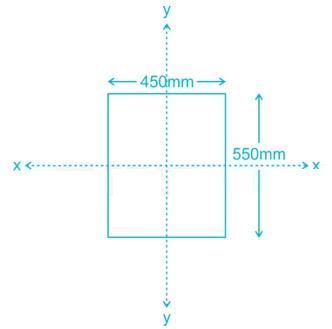
Minimum eccentricity (ex-x) is greater of

(ii) 20 mm
So, ex-x = 25.33 mm
ex-x < 0.05 × 550
25.33 < 27.5 mm
(O.K)
For ey−y =  = 22mm
= 22mm
 = 22mm
= 22mmey-y < 0.05 × 450
22 mm < 22.5 mm
(O.K)
So, Load carrying capacity of the column will be
Pu = 0.4 fck Ac + 0.67fy Asc
fck = 20 N/mm2

= 1963.50mm2
fy = 415 N/mm2
Pu = 0.4 × 20 × [450 × 550 – 1963.50] + 0.67 × 415 × 1963.50
Pu = 2510.24 kN
Select the pair that best expresses a relationship similar to that expressed in the pair:
LIGHT : BLIND- a)Speech : Dumb
- b)Language : Deaf
- c)Tongue : Sound
- d)Voice : Vibration
Correct answer is option 'A'. Can you explain this answer?
LIGHT : BLIND
a)
Speech : Dumb
b)
Language : Deaf
c)
Tongue : Sound
d)
Voice : Vibration

|
Rahul Chatterjee answered |
A blind person cannot see the light and a dumb person cannot speak. so option (a) is correct.
A new flag is to be designed with six vertical stripes using some or all of the colours- yellow, green, blue and red. Then the number of ways this can be done such that no two adjacent stripes have the same colour out is:- a)12×81
- b)16×25
- c) 20×125
- d) 24×216
Correct answer is option 'A'. Can you explain this answer?
a)
12×81
b)
16×25
c)
20×125
d)
24×216
|
|
Neha Choudhury answered |
Since no adjacent stripes contain the same color. The second, and the remaining vertical
stripe will have only three options, while the first will have any of the four options.
4*3*3*3*3*3 = 12* 3^4 = 12 * 81.
So the answer is A.
The Thiessen weights of 4 raingauges A, B, C and D covering a river basin are 0.15, 0.25, 0.30 and 0.30 respectively. If the average depth of rainfall for the basin is 5 cm, the rainfall recorded at B, C and D are 5 cm, 4 cm and 5 cm respectively. What is the rainfall at A?- a)5 cm
- b)6 cm
- c)7 cm
- d)8 cm
Correct answer is option 'C'. Can you explain this answer?
a)
5 cm
b)
6 cm
c)
7 cm
d)
8 cm
|
|
Sanya Agarwal answered |
Chapter doubts & questions for Practice Test: Full Length - 6 Months Preparation for GATE Civil Engg 2025 is part of Civil Engineering (CE) exam preparation. The chapters have been prepared according to the Civil Engineering (CE) exam syllabus. The Chapter doubts & questions, notes, tests & MCQs are made for Civil Engineering (CE) 2025 Exam. Find important definitions, questions, notes, meanings, examples, exercises, MCQs and online tests here.
Chapter doubts & questions of Practice Test: Full Length - 6 Months Preparation for GATE Civil Engg in English & Hindi are available as part of Civil Engineering (CE) exam.
Download more important topics, notes, lectures and mock test series for Civil Engineering (CE) Exam by signing up for free.
6 Months Preparation for GATE Civil Engg
488 videos|1261 docs|878 tests
|

Contact Support
Our team is online on weekdays between 10 AM - 7 PM
Typical reply within 3 hours
|
Free Exam Preparation
at your Fingertips!
Access Free Study Material - Test Series, Structured Courses, Free Videos & Study Notes and Prepare for Your Exam With Ease

 Join the 10M+ students on EduRev
Join the 10M+ students on EduRev
|

|
Create your account for free
OR
Forgot Password
OR
Signup to see your scores
go up within 7 days!
Access 1000+ FREE Docs, Videos and Tests
Takes less than 10 seconds to signup

